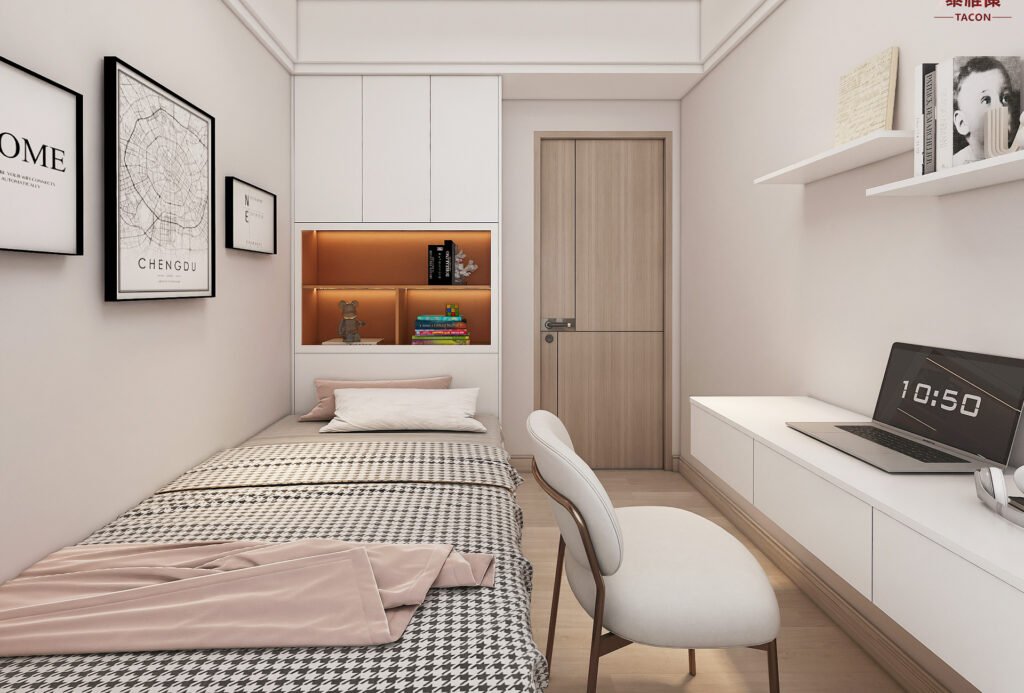MR board, short for Moisture-Resistant Board, is a specially treated particle board designed to resist humidity, making it an ideal material for use in kitchens, bathrooms, laundry rooms, and other moisture-prone areas. However, not all boards labeled as particle board are truly moisture-resistant.
Here’s how to accurately identify high-quality MR board and make the right choice for your interior or furniture projects.

1. Look for a Green-Tinted Core
One of the easiest ways to recognize moisture-resistant particle board is by checking the core color. Many manufacturers add a green tint to distinguish it from standard particle board. While not all moisture-resistant boards are colored, this feature is common in high-quality products.
2. Check for a Water-Resistant Sealant or Coating
Moisture-resistant particle board is often treated with special resins or sealants that help reduce water absorption. Inspect the surface and edges for a smooth, sealed finish, which prevents moisture from penetrating the board. Some boards may also have a laminated or melamine-coated surface for extra protection.
3. Test Water Absorption
A quick test to check moisture resistance is to place a few drops of water on the board’s surface and observe how it reacts.
- If the water beads up and stays on the surface, the board has a moisture-resistant treatment.
- If the water absorbs quickly, the board is not moisture-resistant and may swell over time in humid conditions.
4. Look for Certifications and Manufacturer Labels
Reliable manufacturers often provide certifications or markings on the board indicating moisture resistance. Look for labels such as:
- MR (Moisture Resistant) or HMR (High Moisture Resistance)
- E0 or E1 formaldehyde emission standards, which ensure safety for indoor use
- ISO or EN standards that confirm quality and performance
5. Inspect the Density and Edge Structure
Moisture-resistant particle board is typically denser and more compact than standard particle board. The edges should feel firm, with no loose fibers or gaps. A well-pressed, high-density board provides better resistance to swelling and warping.
6. Consider the Application Environment
If you’re using particle board in areas with high humidity or potential water exposure, opt for boards labeled water-resistant rather than standard ones. For applications like kitchen cabinets, bathroom vanities, and flooring underlayment, moisture-resistant options will provide better longevity.

Choose Tacon Wood Industry for High-Quality MR Board
Tacon Wood Industry specializes in producing high-quality moisture-resistant particle board for furniture, interior design, and construction. Our boards are durable, cost-effective, and designed to withstand humid conditions.
For inquiries, contact us at taconsales86@gmail.com and let us help you find the perfect particle board for your project!
Frequently Asked Questions About MR Board (Moisture-Resistant Board)
Q1: What is MR board used for?
A: MR board (Moisture-Resistant board) is commonly used in interior spaces with moderate humidity, such as kitchen cabinets, bathroom vanities, wardrobes, laundry room shelving, and office furniture. It is not suitable for outdoor use or direct water contact.
Q2: Is MR board waterproof?
A: No, MR board is moisture-resistant, not fully waterproof. It can withstand occasional humidity and dampness but should not be used in areas with prolonged water exposure or outdoor environments. For high-moisture or wet areas, HMR (High Moisture Resistance) or BWP (Boiling Water Proof) boards are more suitable.
Q3: What’s the difference between MR board and HMR board?
A:
- MR board is moisture-resistant and works well in interiors with occasional humidity.
- HMR board (High Moisture Resistant) offers a higher level of water resistance, making it more durable in bathrooms, laundries, and commercial wet areas.
Q4: How can I tell if a board is truly moisture-resistant?
A: Look for these indicators:
- Green-tinted core (common in MR or HMR boards)
- Sealed or laminated surfaces
- Certifications or labels such as MR/HMR, E0/E1 emission grades
- A water bead test can also help—if water stays on the surface without absorption, the board is likely moisture-resistant.
Q5: Can MR board be painted or laminated?
A: Yes. MR boards have a smooth and compact surface that can be laminated with decorative paper, PVC film, or melamine. They can also be painted after proper priming and sealing of the edges.
Q6: Is MR board eco-friendly?
A: Many MR boards—including those from Tacon Wood Industry—are made with E0 or E1 formaldehyde-emission standards, ensuring safe indoor air quality. Some products are also manufactured using recycled wood materials, making them more environmentally responsible.
Q7: Where can I buy moisture-resistant particle board in bulk?
A: You can contact Tacon Wood Industry at taconsales86@gmail.com for high-quality MR boards available in custom sizes, thicknesses, and finishes. OEM and bulk export options are available.




